Introduction
I have been fascinated by quasars and extremely far away deep sky objects since I got my first telescope. My first image of such an object was, no doubt, 3C273, in March 1995.
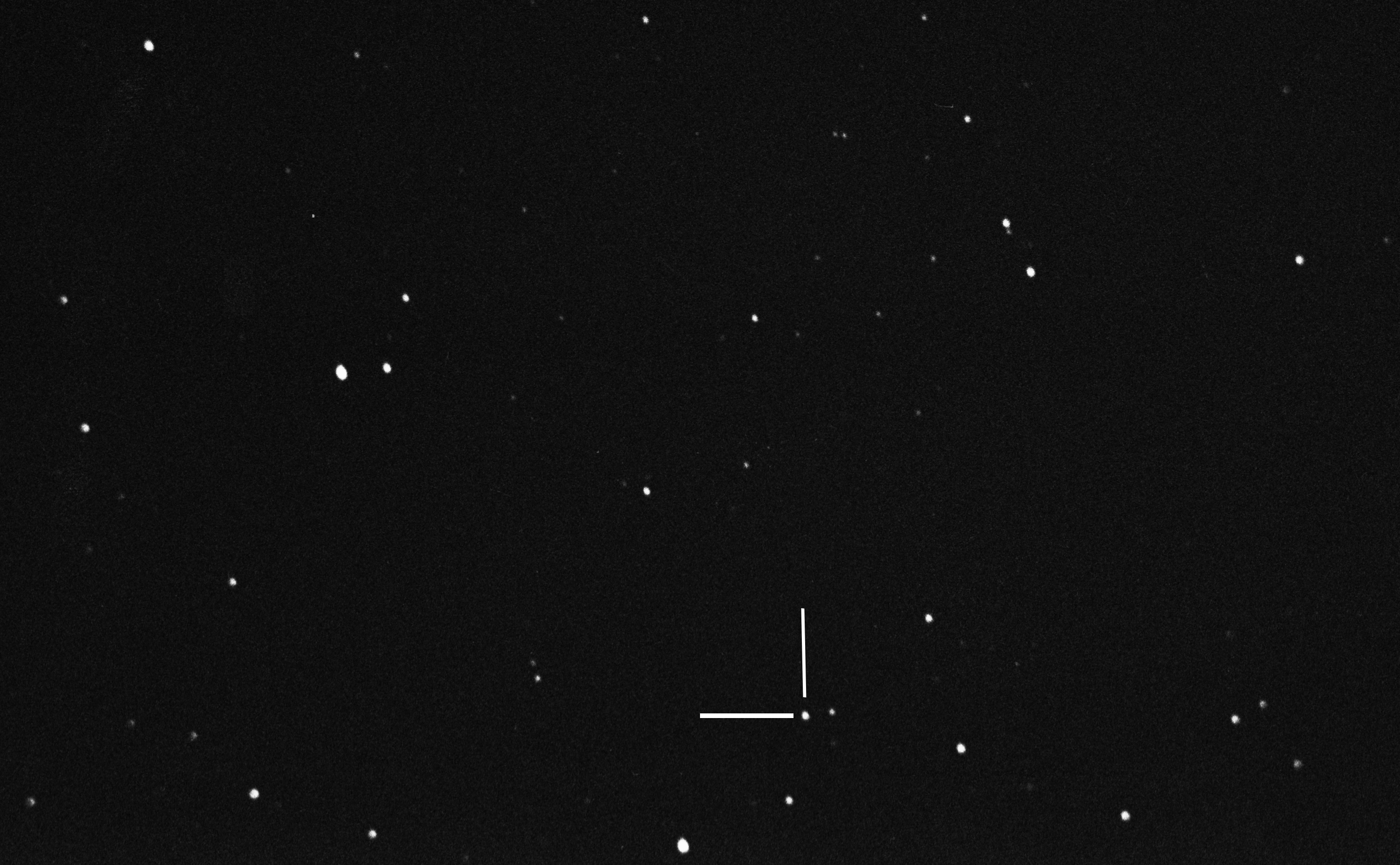
This image (only one frame) was taken from Valldoreix, Barcelona, with a C8″, a Nikkormat FTN camera, Kodak TMax400 B&W film (pushed at ISO 800, developed at home), exposure time 600s and auto-guided with an ST-4. Due to my professional obligations by that time, I soon forgot about taking more challenging objects, but the first one was in the bag!
But when, 17 years later, I bought a C11″HD, the FLI6303E (sensitivity ISO 5500) and built my own observatory in Corbera, Barcelona, I decided to get back to this project. When I came to Philadelphia (mid 2014), I kept on imaging for this project, this time Christian Sasse, happily for me, joined the project. This is the story of this project, including the “whats”, the “whys” and very especially, the “hows”. Christian says that we joined “obsessions”. I totally agree to him. Anyhow, quite often, “obsessions” really move brains and bodies and are the igniting spark of achievement…
The “why”
I have always read a lot about Astronomy-related matters, especially about Cosmology, the main reason to finally land on Astronomy as a passion. I find exciting to know about the origin and evolution of the Universe, from the Big Bang to nowadays. If you get an image of the Sun, you get an image of how the Sun was like just 8 minutes 11 seconds ago. If you are imaging M31, the Andromeda Galaxy, you see how it looked like 2.3 million years ago. Imaging 3C273 means getting light that left this object 1,928 million years ago (please find a calculator here, this age has been calculated with the currently most accepted values of the Hubble constant, H0: 72, Ωmatter: 0.27, and ΩΛ:0.73). And this quasar is just one of the closest… This is why I wanted to get images of far away objects in the sky. As far as we can get…
The “how”
Before going to the “whats” (the objects that have been imaged), it will be good that we go for the “hows”, meaning with this the tools I have been using and why have I used these ones and none other. The telescopes and, very especially, the cameras that have been chosen, are very important for the success in this project. A basic assumption for this project has always been that it had to be performed only with amateur equipment. We define as “amateur equipment” the “off-the-shelf” telescopes, mounts and cameras. We exclude from this definition those professional, custom made pieces such as telescopes, professional extremely refrigerated cameras… (even if they are really wonderful…). This was a requirement for us, because with professional equipment you can get very deep images capturing objects with redshifts above 11 (Hubble Space Telescope, Spitzer…). This had to be (and it indeed is) an amateur project.
The “what”
Many different objects have been attempted. Not all popped up, but many did. The images that have been confirmed include quasars with redshift z ranging from 0.03 (in fact this one was a BL Lacertae object) up to 6.41 (this one captured by Christian Sasse) as well as active galaxies with redshifts z ranging from 5.16 up to 7.48. We tried to capture also the farthest quasar known as of today, showing a redshift z=7.08, but all attempts were in vain, even after taking 60x10min subframes. It is too dim and too red to be captured with the equipment used.
The project started with relatively close, lower redshift objects. Christian Sasse and myself were imaging these objects separately. When I was still capturing lower redshift objects, he got an impressive image of a quasar with z=6.41. At that time, Christian held then, by imaging this object, the world record of the farthest away object ever imaged with “amateur equipment”. Some time later, I got (with the same telescope as Christian) the image of a still farther away galaxy with a redshift z=6.70 (then this galaxy was the record of the farthest object ever imaged with amateur equipment). Then we contacted each other and decided to go ahead together and add up experiences and goals (and obsessions…). We imaged together several active galaxies around z=7.0 and finally got our farthest away active galaxy showing a redshift of z=7.48. It will be pretty difficult that this record will be nailed down. Farther away objects would need different (“professional”) tools, that are out of the scope of this project. This is the story of a project with a happy ending and some success.
Once the project has been introduced, let’s describe everything in some detail.
Project “Getting images of high redshift objects”
Goal
The goal of this project is to get images of low, medium and high redshift objects, using only “amateur” equipment. Defining “amateur” as “off-the-shelf” mass-produced products that can be easily bought in a shop or online.
Redshift
(Just a brief description, to put the project in context. See also here)
The Universe started with a big explosion, called the Big Bang. It has been expanding ever since. Due to this expansion, all objects drift apart form each other at speeds that, according to the current knowledge, are increasing due to the effect of the Dark Energy. According to the Hubble Law, the speed at which a specific object recedes is directly proportional to its distance: v=H0·d, where H0 is the Hubble constant. Currently, its most accepted value is 72. If the distance is input in Megaparsecs (1 Megaparsec means about 3.26 million light years), then the recession speed, v, is expressed in km/sec.
Hence, the farther away an object is, the fastest is this object “receding” (getting farther away) from us. According to the Doppler effect, the light emitted by such objects reduces its frequency (increasing its wavelength) thus being shifted towards the red region of the spectrum. Should this object move towards us, its light would be, correspondingly, blue-shifted. The quantification of this shift to the red is called redshift and it is calculated in different ways, but one of them is as a function of the increase of the observed wavelength (∆λ=λobs-λ), compared to the same emission line in rest (λ): z= ∆λ/λ
being Δλ the increase in wavelength and λ the wavelength measured from an object that is not receding or approaching us. The higher the redshift, z, the farther away is our object, the fastest it recedes away from us and the longer it has taken for light to reach us. As an example, a z=0.158 (the one shown by 3C273) means that we speak of a distance of about 2 billion light years away, about the same time of travel and a recession speed of about 14.5% of the speed of light (45,000 km/sec 0r about 27,000 miles per second!!). Talking of redshift is the same as talking of x million (or billion) years ago. The higher the redshift, z, the greater the number of billion years ago we are talking about.
Our objects will have their light highly redshifted, and their light will enter the realm of the Near Infra Red (NIR), with wavelengths around 800-1100 nm, out of reach for cameras devoted solely to the visible range (400-750 nm).
Cosmological Significance
Imaging objects with increasing redshift, z, means looking back in time. This, in itself, could be already considered as a goal, but the interesting part is that we get images of objects just as they were, back in time, during specific periods of the evolution of the Universe.
It is not the goal of this text to teach about the Big Bang and the evolution of the Universe, but just to put everything in context, I summarize the most important phases of the evolution of the Universe, as well as their position in the Universe’s timeline:
- Once the so called “primordial super-atom” blasts, there is a very short period that is extremely important for the ulterior evolution, the first 10-32s=0.000 000 000 000 000 000 000 000 000 000 01 seconds. This period ends when the “Inflation” ends.
- The second period lasts until the Universe is 380,000 years old. The atoms form and the Universe becomes transparent. Then the afterglow of the Big Bang, the Cosmic Microwave Background (CMB) can be seen.
- The third period would be the Reionization. The stars, quasars and galaxies start to form and their emitted energy reionizes the neutral atoms, making the environment less transparent to light (photons) due to the fact that they interact (collisions) with electrons and protons. This period is very important and lasts between 150 million and 1 billion years after the BB. This means that we speak that this period took place between redshifts 20 and 6. Everything that we can get its image showing a redshift greater than 6, means to be seeing an early galaxy/quasar within the Reionization period, at a time close to their formation!
- Following periods imply the generation of second (and further on) generation of stars, galaxies, clusters… it lasts until today… 13.77 billion years from the BB, and corresponding to redshift z=0.

Objects to be imaged
The objects to be imaged are bright and far away active galaxies. These galaxies have nuclei that can outshine all of the other stars of the galaxy together. This is usually possible by the interaction of a supermassive black hole (with mass of several million to some billion Suns) with the surrounding stars or InterStellar Medium (ISM). There are several different types of these galaxies:
- BL Lacertae objects, active galaxies characterized by their variability and light polarization. They show featureless continuous spectra.
- Quasars, bright active galactic nuclei do show emission lines in their spectra and are pushing off immense amounts of energy. Their parent galaxies are not usually seen (except for the closest ones, like 3C273) and therefore they show up as “stars”. This is the origin of their name: QUAsi-StellAr-Radio-objects, or also QSOs.
- Seyfert Galaxies, nominally much less bright than quasars, they appear as normal galaxies, but their central black holes modify their spectra. They are strictly defined by their spectra. These galaxies, due to their lower intrinsic brightness, have not been considered for this project.
- LINERs, Low-Ionization Nuclear Emission-Line Region, are usually nearby galaxies, that are not considered for this project and
- Radio galaxies, strong radio emitters, often showing one or two jets, that were detected and better studied in the radio range. They are not considered for this project.

This graph is Copyrighted by keel@bildad.astr.ua.edu
The final list of objects to be imaged contained 23 objects of the first two types. About two thirds (15) were effectively imaged.
Equipment
In order to appropriately choose the equipment to image these objects, we find that the two most important elements will be the telescope and the camera. Probably, the camera is even more important than the telescope itself, as there are many large aperture telescopes available in remote telescopes networks, but the difference, for this project, is clearly made by the camera.
1. Telescope
Our objects look mostly “star-like” and therefore the larger the aperture of the telescope, the better. For dim extended deep sky objects, the important factor is not the aperture but the focal ratio, f. Anyhow, medium large apertures can still be enough for even quite dim objects to be imaged.
As a medium large aperture, the 11″ Celestron 11HD was fitting perfectly. We will call it Telescope 1.
For dimmer, farther away objects, a larger aperture and a faster (lower) focal ratio is needed. A larger such telescope could be found in the iTelescope.net network. T17 is a 17 inch (431mm) aperture telescope, with a focal ratio f/6.8. Other large (even larger) telescopes do exist in this network, but none of them had the camera this one has. This telescope will be called Telescope 2. This telescope was located, some years ago, in Nerpio, Spain. Now it is located in Siding Spring (SSO) in Australia.
2. Camera
Astronomical CCD cameras come in, mainly, three “flavors”:
2.1. Front lit with Anti-Blooming Gate (ABG). This is the most popular camera type among astrophotographers. It allows imaging without the well known “star-streaks” due to “bleeding” of the collected light on very bright stars. The ABG treatment reduces the ISO sensitivity and their ISO sensitivity is, usually, around 1600.
Of paramount importance is the Quantum Efficiency (QE) profile. A typical QE profile for such cameras can be the one below:
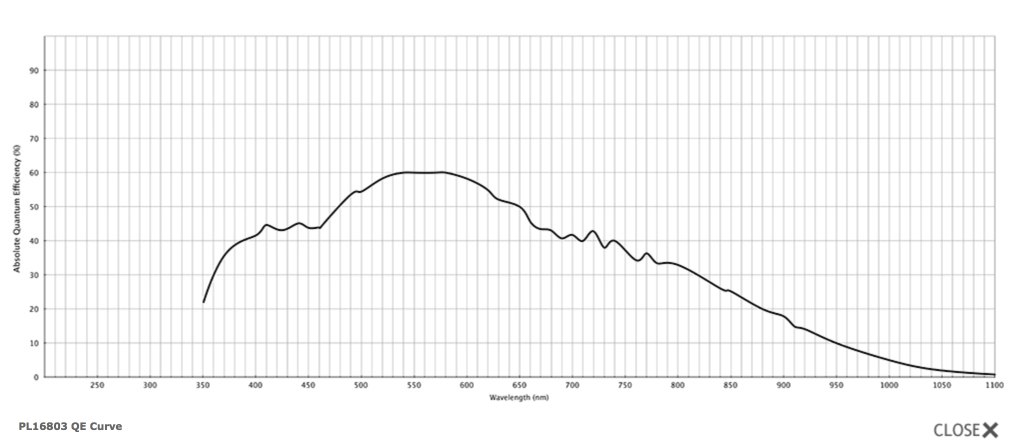
In this case, this is the QE profile of the FLI PL16803. It is easy to see that this otherwise excellent camera has been optimized for imaging in the visible range. Its sensitivity in the NIR is low and reaches near zero values when the wavelength reaches 1000nm.
2.2. Front lit without Anti-Blooming Gate (NABG). The first astronomical CCD cameras were NABG. There are still a few that are this type. The main advantage is their higher sensitivity. They usually have sensitivities in the range ISO 3500-6000. The main drawback is the “bleeding” of the brighter stars (see image below):
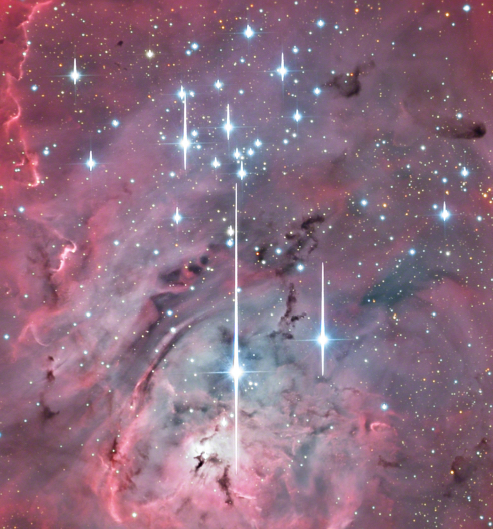
They show, however, a high sensitivity, and this is a positive factor for our project, thus shortening the exposure time by a factor of at least three to nearly four compared to ABG cameras. Here is the QE profile of such a camera:

This camera has a higher QE maximum (68% compared to 60% the ABG camera), but its sensitivity in the NIR is still quite low. This specific camera has a measured sensitivity of ISO 5500. This is the camera I had when I was still living in Barcelona. It is very good for color, but optimized for reds (Hydrogen alpha).
2.3. Backlit cameras. These cameras are less popular and mostly devoted to specific work (mainly scientific or science-based). They are also NABG cameras and have a very high sensitivity. The QE profile of such a camera would be like the one below:
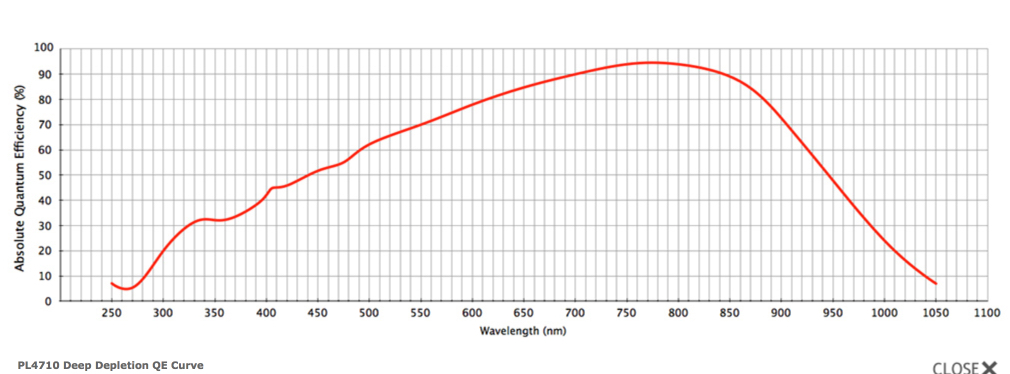
This camera has a much higher QE maximum (95%) and it is remarkable that this maximum is at the start of the NIR (780nm). This one is the camera attached to T17, the second telescope chosen for the project. Its sensitivity has been measured at ISO 35000.
Overlapping both QE profiles, we find that their behavior is completely different and they complement each other:
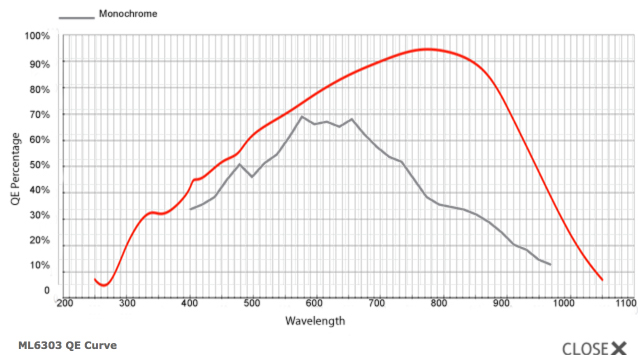
We have to take mainly into account which wavelengths we have to detect. There are two emission lines that, being very important, are strong enough to be quite conspicuous in the spectra of the different objects: the Hydrogen alpha (at 656.28nm for an object in rest, Red) and the Lyman alpha (at 121.6nm for an object in rest, clearly in the UV, not visible when in rest). Just for the record, I attach here below a table with the resulting wavelengths (in nm) for these two emission lines when the redshift of the object increases:
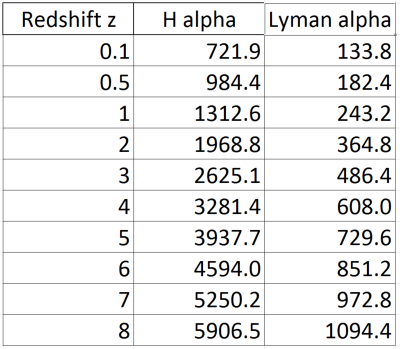
This means that we won’t be able to follow the Halpha line, because it will be lost very soon (z=0.5 at most), but if we try to get the Lyman alpha line, we can go quite far away with the ML 6303E and get the final objects with the PL4710. The Lyman alpha goes into the visible spectrum at z approx. 2.5 and it enters the realm of the NIR after a z=5.
If we discard the ABG cameras for this kind of project, the chosen cameras will be, therefore, the FLI ML6303E, for the lower to medium high redshifts (up to z=3) and the FLI PL4710 for the higher redshift objects.
Results. Objects imaged
The objects that were imaged will be shown in order of increasing redshift.
1 Redshift z=0.03
Object: Markarian 421
Type: BL Lacertae object
Magnitude: 13.50
Redshift: 0.03
Light traveled for: 399 Million years
Age of the Universe when it left: 13,371 Million years
Age of the Universe when it left: 97.1 % of present age
Recedes at: 2.96 % of c (speed of light)
RA: 11h 04m 27.31s
Dec: +38º 12’ 31.8”
Telescope: Celestron 11” HD f/10
Camera: FLI ML6303 (3072x2048pix)
Total exposure: 11 min
Processing: PixInsight

Actual image taken with C11
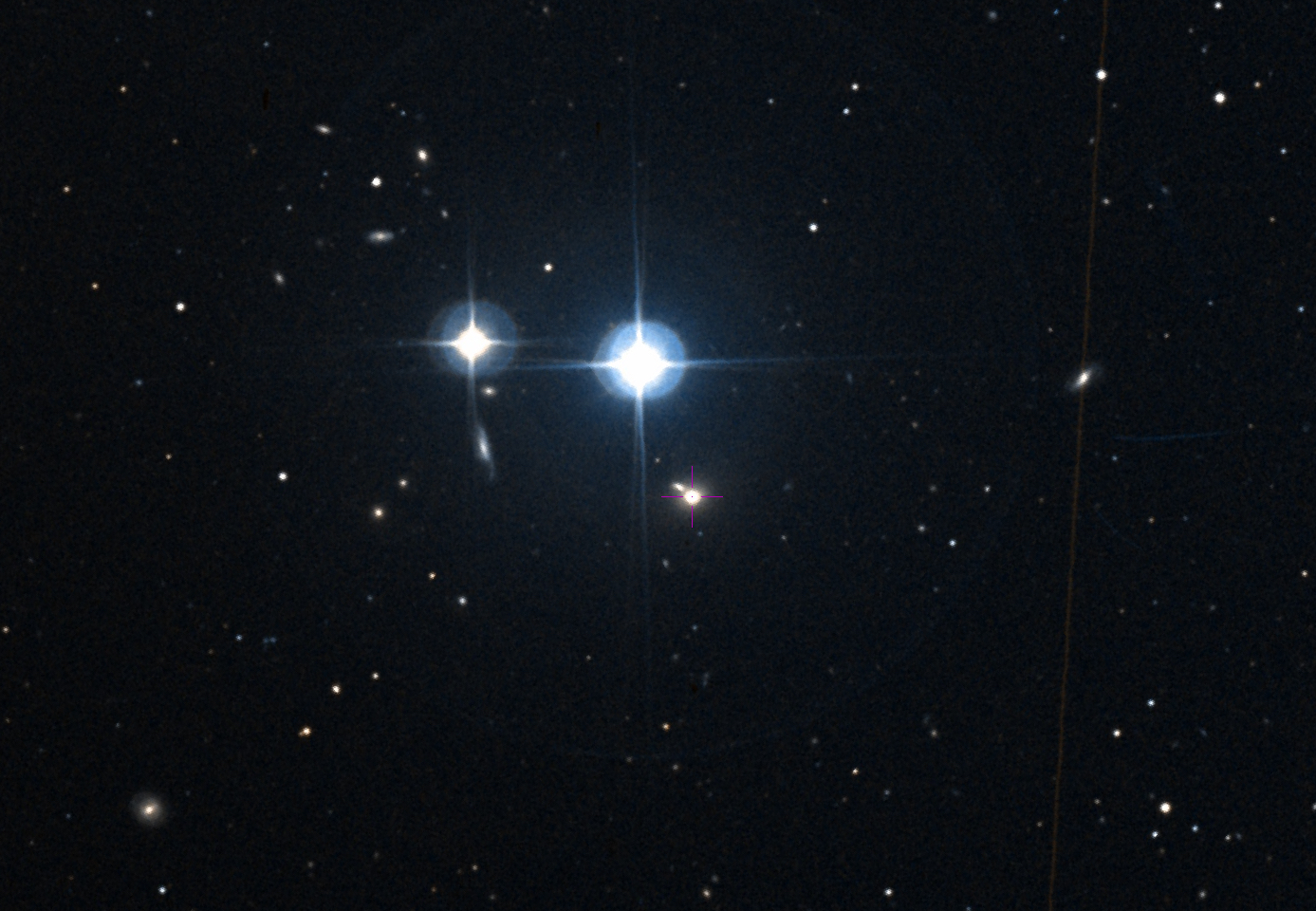
Same field from University of Strasbourg (Aladin). Object is marked with crosshairs
This means that the light that has been captured in this image, left in this point of the evolution of the Universe:
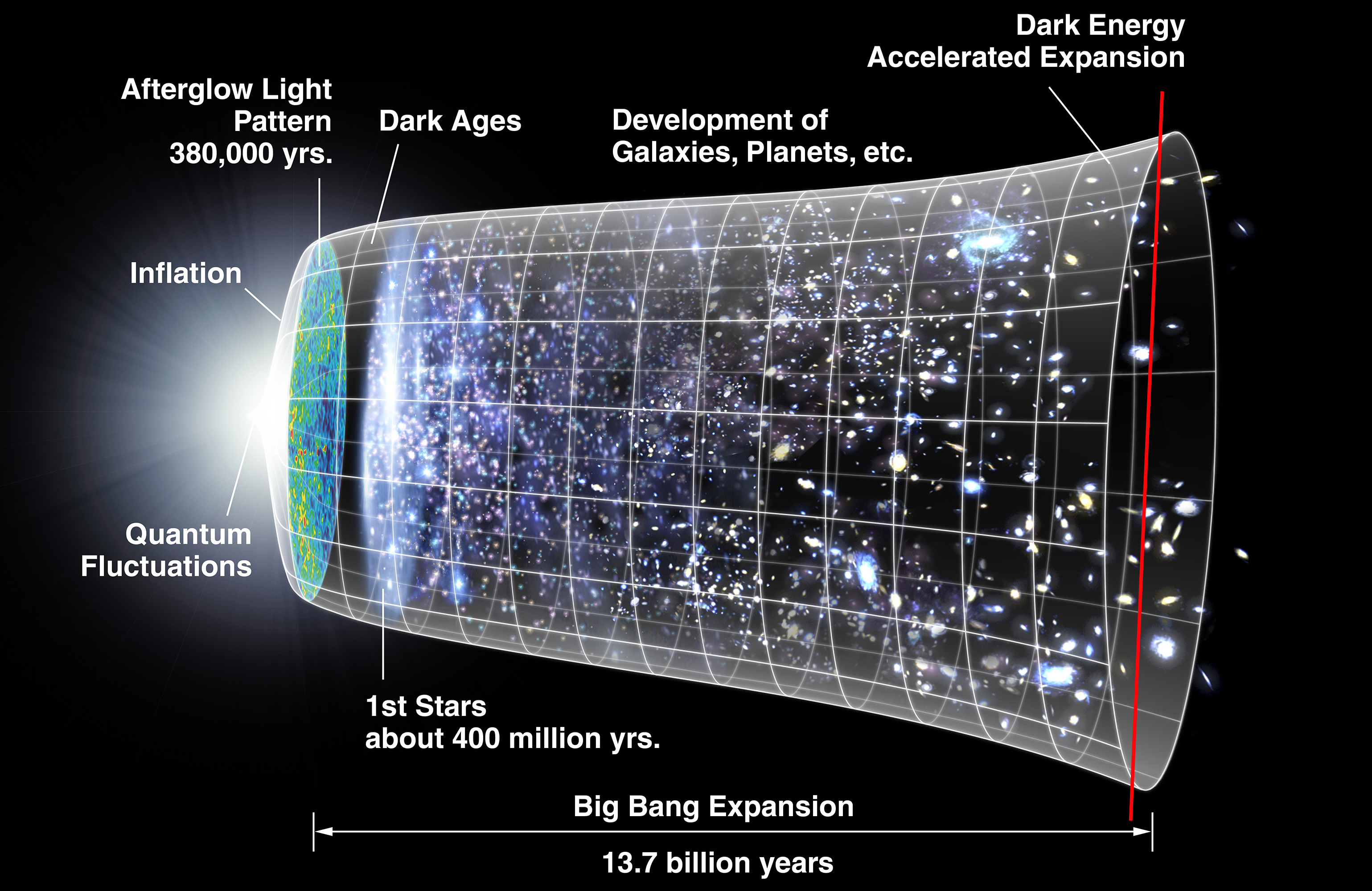
2 Redshift z=0.158
Object: QSO 3C273
Type: Quasar
Magnitude: 13.05
Redshift: 0.158
Light traveled for: 1,928 Million years
Age of the Universe when it left: 11,842 Million years
Age of the Universe when it left: 86.0 % of present age
Recedes at: 14.57 % of c (speed of light)
RA: 12h 29m 06.7s
Dec: +02º 03’ 08.7”
Telescope: Celestron 11” HD f/10
Camera: FLI ML6303 (3072x2048pix)
Total exposure: 11 min
Processing: PixInsight

Actual image with C11
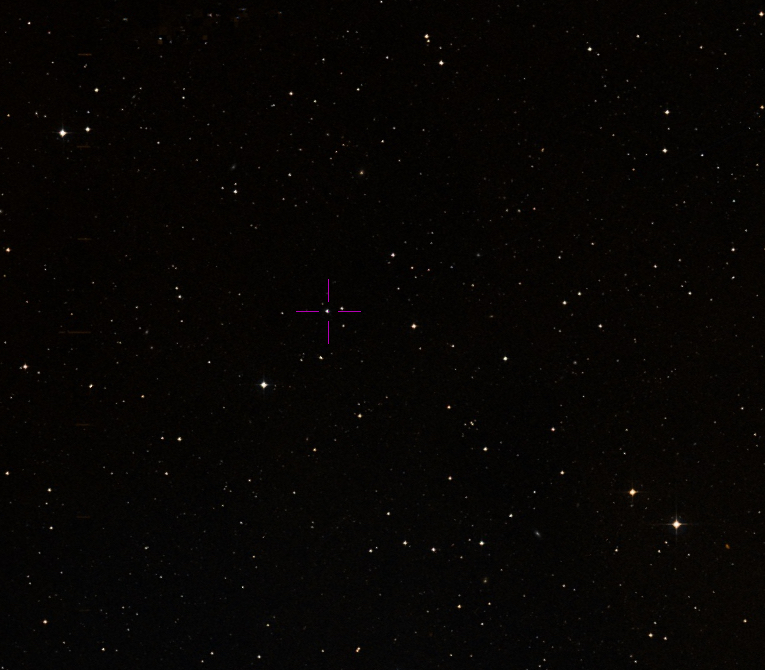
Same field from University of Strasbourg (Aladin). Object is marked with crosshairs
This means that the light that has been captured in this image, left in this point of the evolution of the Universe:

3 Redshift z=0.538
Object: QSO 3C279
Type: Quasar
Magnitude: 17.75
Redshift: 0.538
Light traveled for: 5,211 Million years
Age of the Universe when it left: 8,559 Million years
Age of the Universe when it left: 62.16 % of present age
Recedes at: 40.57 % of c (speed of light)
RA: 12h 56m 11.17s
Dec: -05º 47’ 21.5”
Telescope: Celestron 11” HD f/10
Camera: FLI ML6303 (3072x2048pix)
Total exposure: 10 min
Processing: PixInsight
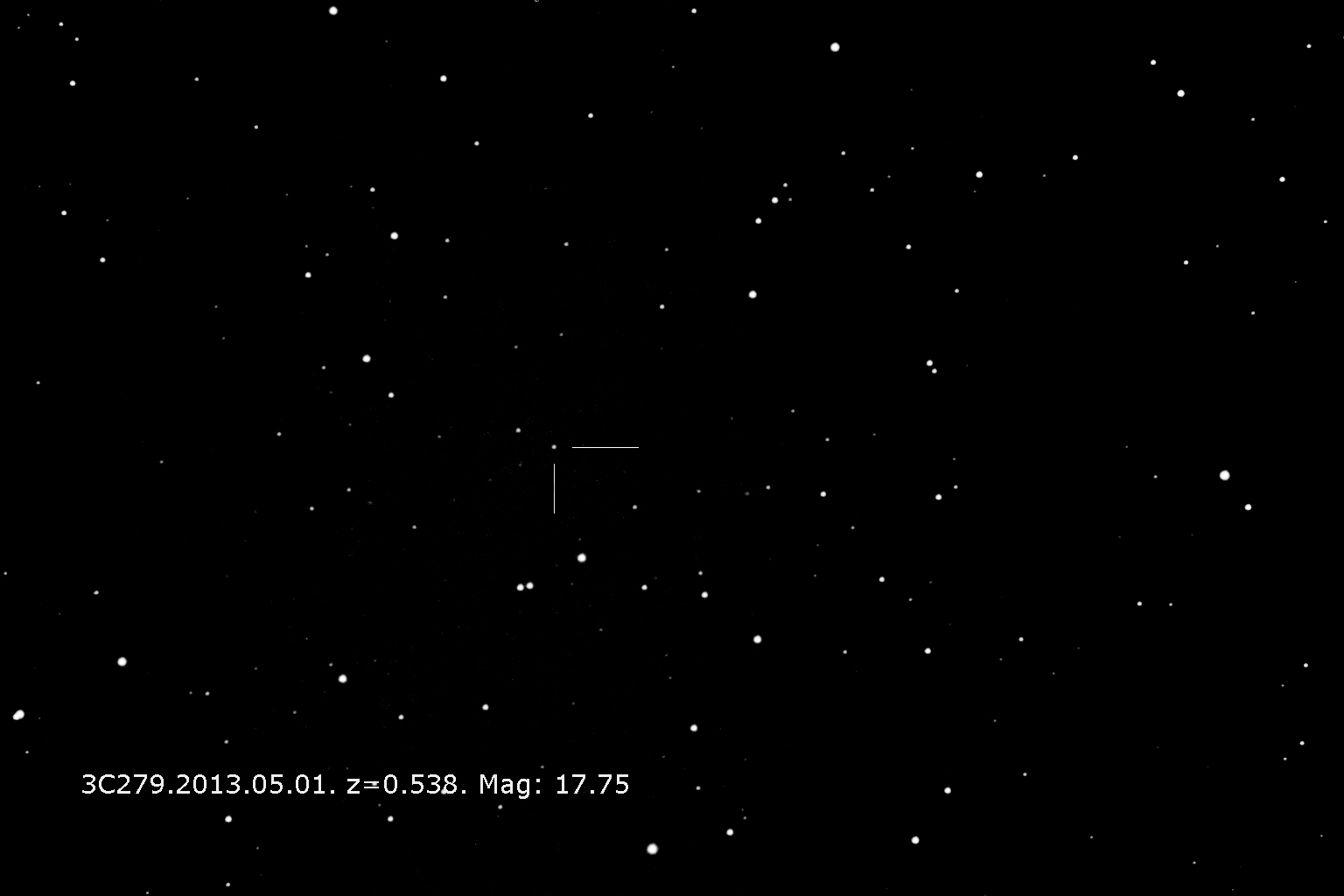
Actual image taken with C11

Same field from University of Strasbourg (Aladin). Object is marked with crosshairs
This means that the light that has been captured in this image, left in this point of the evolution of the Universe:

4 Redshift z=2.043
Object: QSO LB-19
Type: Quasar
Magnitude: 16.12
Redshift: 2.043
Light traveled for: 10,248 Million years
Age of the Universe when it left: 3,522 Million years
Age of the Universe when it left: 25.58 % of present age
Recedes at: 80.51% of c (speed of light)
RA: 12h 50m 05.73s
Dec: +26º 31’ 07.5”
Telescope: Celestron 11” HD f/10
Camera: FLI ML6303 (3072x2048pix)
Total exposure: 10 min
Processing: PixInsight

Actual image taken with C11

Same field from University of Strasbourg (Aladin). Object is marked with crosshairs
This means that the light that has been captured in this image, left in this point of the evolution of the Universe:

5 Redshift z=3.053
Object: QSO J111101.3-150518.53
Type: Quasar
Magnitude: 18.2
Redshift: 3.053
Light traveled for: 11,358 Million years
Age of the Universe when it left: 2,412 Million years
Age of the Universe when it left: 17.52 % of present age
Recedes at: 88.52% of c (speed of light)
RA: 11h 11m 01.3s
Dec: -15º 05’ 18.53”
Telescope: Planewave CDK17″ f/6.8
Camera: FLI PL4710 (1024x1024pix)
Total exposure: 25 min
Processing: PixInsight

Actual image taken with T17

Same field from University of Strasbourg (Aladin). Object is marked with crosshairs

Spectrum as shown in SDSS DR9
This means that the light that has been captured in this image, left in this point of the evolution of the Universe:

6 Redshift z=4.03
Object: QSO J125336.36-022807.8
Type: Quasar
Magnitude: 20.48
Redshift: 4.03
Light traveled for: 11,940 Million years
Age of the Universe when it left: 1,830 Million years
Age of the Universe when it left: 13.29 % of present age
Recedes at: 92.40% of c (speed of light)
RA: 12h 53m 36.36s
Dec: -02º 28’ 07.8”
Telescope: Planewave CDK17″ f/6.8
Camera: FLI PL4710 (1024x1024pix)
Total exposure: 25 min
Processing: PixInsight

Actual image taken with T17

Same field from University of Strasbourg (Aladin). Object is marked with crosshairs

Spectrum as shown in SDSS DR9
This means that the light that has been captured in this image, left in this point of the evolution of the Universe:

7 Redshift z=5.1635
Object: LEDA 42449
Type: Galaxy
Magnitude: 16.67
Redshift: 5.1635
Light traveled for: 12,342 Million years
Age of the Universe when it left: 1,428 Million years
Age of the Universe when it left: 10.37 % of present age
Recedes at: 94.87 % of c (speed of light)
RA: 12h 40m 23.8s
Dec: +02º 36’ 29.8”
Telescope: Planewave CDK17″ f/6.8
Camera: FLI PL4710 (1024x1024pix)
Total exposure: 50 min
Processing: PixInsight

Actual image taken with T17

Same field from University of Strasbourg (Aladin). Object is marked with crosshairs
This means that the light that has been captured in this imaged left in this point of the evolution of the Universe:

8 Redshift z=5.18
Object: J140025.54-012957.02
Type: Quasar
Magnitude: 19.07
Redshift: 5.18
Light traveled for: 12,347 Million years
Age of the Universe when it left: 1,423 Million years
Age of the Universe when it left: 10.33 % of present age
Recedes at: 94.90 % of c (speed of light)
RA: 14h 00m 25.54s
Dec: -01º 29’ 57.02”
Telescope: Planewave CDK17″ f/6.8
Camera: FLI PL4710 (1024x1024pix)
Total exposure: 25 min
Processing: PixInsight

Actual image taken with T17

Same field from University of Strasbourg (Aladin). Object is marked with crosshairs
This means that the light that has been captured in this image, left in this point of the evolution of the Universe:

9 Redshift z=6.41
(This image was taken by Christian Sasse in 2011)
Object: J114816.55+525149.5
Type: Quasar
Magnitude: 25.73 (Simbad)
Redshift: 6.41
Light traveled for: 12,616 Million years
Age of the Universe when it left: 1,154 Million years
Age of the Universe when it left: 8.38 % of present age
Recedes at: 96.42 % of c (speed of light)
RA: 11h 48m 16.55s
Dec: +52º 51’ 49.5”
Telescope: Planewave CDK17″ f/6.8
Camera: FLI PL4710 (1024x1024pix)
Total exposure: 995 min (16h 35m)
Processing: Maxim DL and VPhot

Actual image taken with T17. (c) Christian Sasse 2011

Actual image taken with T17 (inset). (c) Christian Sasse 2011

Same field from University of Strasbourg (Aladin). Object is marked with crosshairs
This means that the light that has been captured in this image, left in this point of the evolution of the Universe:

10 Redshift z=6.70
Object: J122719.48-020248.6
Type: Galaxy
Magnitude: 18.40
Redshift: 6.7014
Light traveled for: 12,664 Million years
Age of the Universe when it left: 1,106 Million years
Age of the Universe when it left: 8.03 % of present age
Recedes at: 96.69 % of c (speed of light)
RA: 12h 27m 19.48s
Dec: -02º 02’ 48.6”
Telescope: Planewave CDK17″ f/6.8
Camera: FLI PL4710 (1024x1024pix)
Total exposure: 15 min
Processing: PixInsight

Actual image taken with T17

Same field, but from SDSS DR9

Spectrum from SDSS DR9
This means that the light that has been captured in this image, left in this point of the evolution of the Universe:

11 Redshift z=7.0025
(From this image onwards, the project continues jointly between C. Sasse and J. Drudis)
Object: J122719.48-020248.6
Type: Galaxy
Magnitude: 22.73
Redshift: 7.0025
Light traveled for: 12,710 Million years
Age of the Universe when it left: 1,060 Million years
Age of the Universe when it left: 7.70 % of present age
Recedes at: 96.92 % of c (speed of light)
RA: 22h 52m 42.34s
Dec: +01º 37’ 06.6”
Telescope: Planewave CDK17″ f/6.8
Camera: FLI PL4710 (1024x1024pix)
Total exposure: 100 min
Processing: PixInsight

Actual image taken with T17

Same field from University of Strasbourg (Aladin). Object is marked with crosshairs
This means that the light that has been captured in this image, left in this point of the evolution of the Universe:

12 Redshift z=7.0082
Object: J154847.30+031855.6
Type: Galaxy
Magnitude: 21.75
Redshift: 7.0082
Light traveled for: 12,710 Million years
Age of the Universe when it left: 1,060 Million years
Age of the Universe when it left: 7.70 % of present age
Recedes at: 96.93 % of c (speed of light)
RA: 15h 48m 47.30s
Dec: +03º 18’ 55.6”
Telescope: Planewave CDK17″ f/6.8
Camera: FLI PL4710 (1024x1024pix)
Total exposure: 180 min
Processing: PixInsight

Actual image taken with T17

Same field from SDSS DR9. Object is marked with an arrow

Spectrum from SDSS DR9
This means that the light that has been captured in this image, left in this point of the evolution of the Universe:

13 Redshift z=7.0112
Object: J225847.78+052902.4
Type: Galaxy
Magnitude: 22.76
Redshift: 7.0112
Light traveled for: 12,711 Million years
Age of the Universe when it left: 1,059 Million years
Age of the Universe when it left: 7.69 % of present age
Recedes at: 96.93 % of c (speed of light)
RA: 22h 58m 47.78s
Dec: +05º 29’ 02.4”
Telescope: Planewave CDK17″ f/6.8
Camera: FLI PL4710 (1024x1024pix)
Total exposure: 420 min
Processing: PixInsight

Actual image taken with T17

Same field from SDSS DR9. Object is marked with a square
This means that the light that has been captured in this image, left in this point of the evolution of the Universe:

14 Redshift z=7.0112
Object: J215830.70+063318.7
Type: Galaxy
Magnitude: 21.26
Redshift: 7.0112
Light traveled for: 12,711 Million years
Age of the Universe when it left: 1,059 Million years
Age of the Universe when it left: 7.69 % of present age
Recedes at: 96.93 % of c (speed of light)
RA: 21h 58m 30.70s
Dec: +06º 33’ 18.7”
Telescope: Planewave CDK17″ f/6.8
Camera: FLI PL4710 (1024x1024pix)
Total exposure: 400 min
Processing: PixInsight

Actual image taken with T17

Same field from SDSS DR9. Object is marked with a square

Spectrum from SDSS DR9
This means that the light that has been captured in this image, left in this point of the evolution of the Universe:

15 Redshift z=7.487
Object: HUDF092Y-3037551196
Type: Galaxy
Magnitude: Not recorded
Redshift: 7.487
Light traveled for: 12,773 Million years
Age of the Universe when it left: 997 Million years
Age of the Universe when it left: 7.24 % of present age
Recedes at: 97.26 % of c (speed of light)
RA: 03h 33m 03.78s
Dec: -27º 51’ 20.8”
Telescope: Planewave CDK17″ f/6.8
Camera: FLI PL4710 (1024x1024pix)
Total exposure: 490 min
Processing: PixInsight

Actual image taken with T17

Same field from University of Strasbourg (Aladin). Object is marked with crosshairs
All images in this section have been taken by J. Drudis, except the Quasar J1148+5251, taken by C. Sasse and the galaxies numbered 11 thru 15, that have been taken jointly by C. Sasse and J. Drudis.
Conclusions
As many as 15 low, medium and high redshift objects have been effectively imaged. Starting with image No. 9 (J1148+5251), every new image meant a new world record for the farthest away object ever imaged with amateur equipment. This means that this record has been beaten seven consecutive times. The first time by Christian Sasse alone, the second one (J122719.48-020248.6) by Josep Drudis alone and the following 5, by both working together in this project. A very distant galaxy, dating back to the time of Reionization, whose light was sent away when the Universe was less than a billion years old, and showing a redshift, z=7.487 is, as of today ,the farthest object ever imaged with amateur equipment.
Due to the faintness of this last galaxy, as well as the very high redshift it shows, we consider it very unlikely that a farther object can be imaged with amateur equipment, but the technology keeps on improving and we leave the challenge here for other (amateur) people to try.
Many of the images taken in this project are the only amateur ones for those objects. Only images taken with professional equipment have been found (often taken with much larger telescopes and special cameras cooled with liquid nitrogen or other professional methods).
May 2nd, 2016.